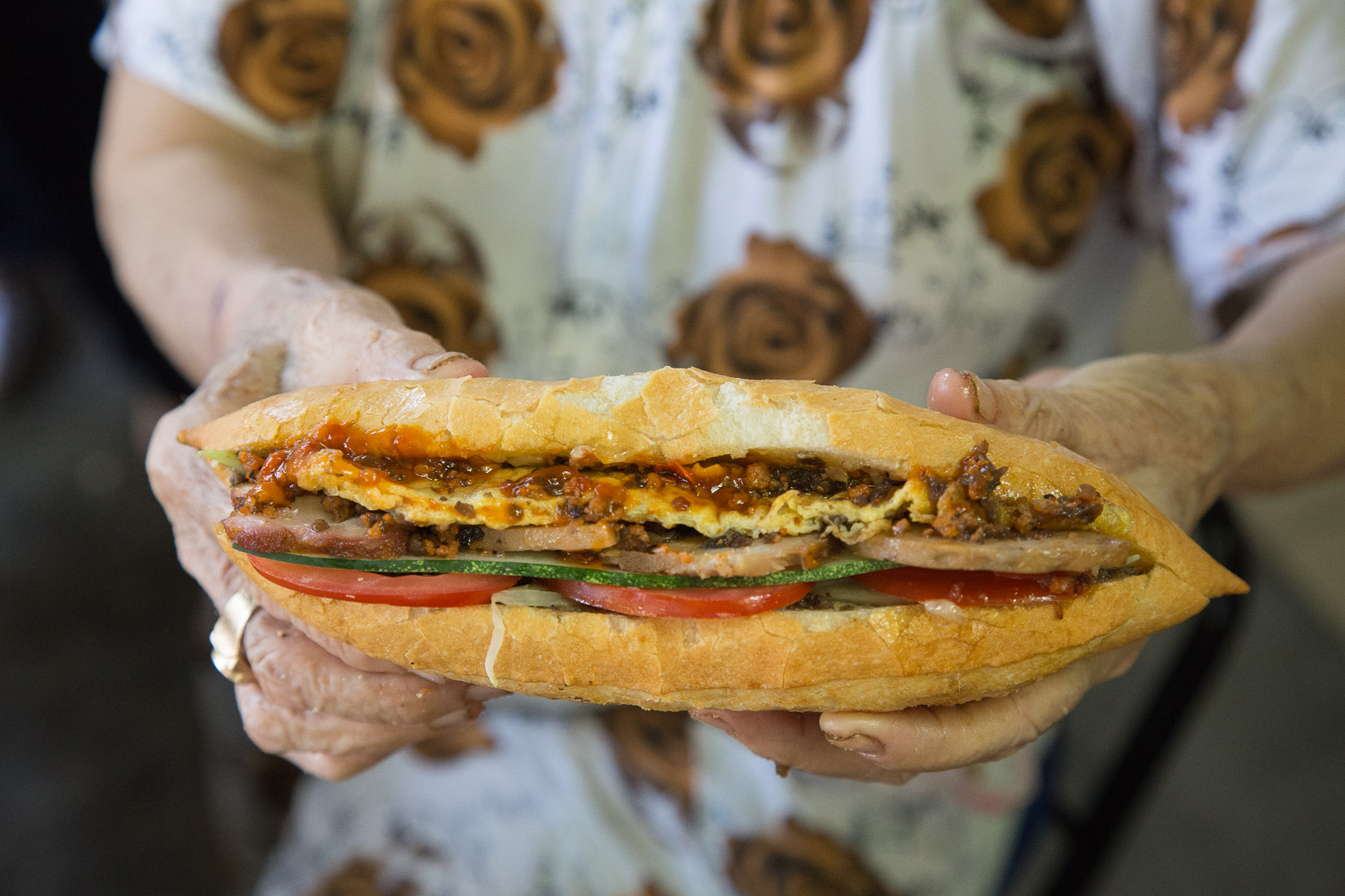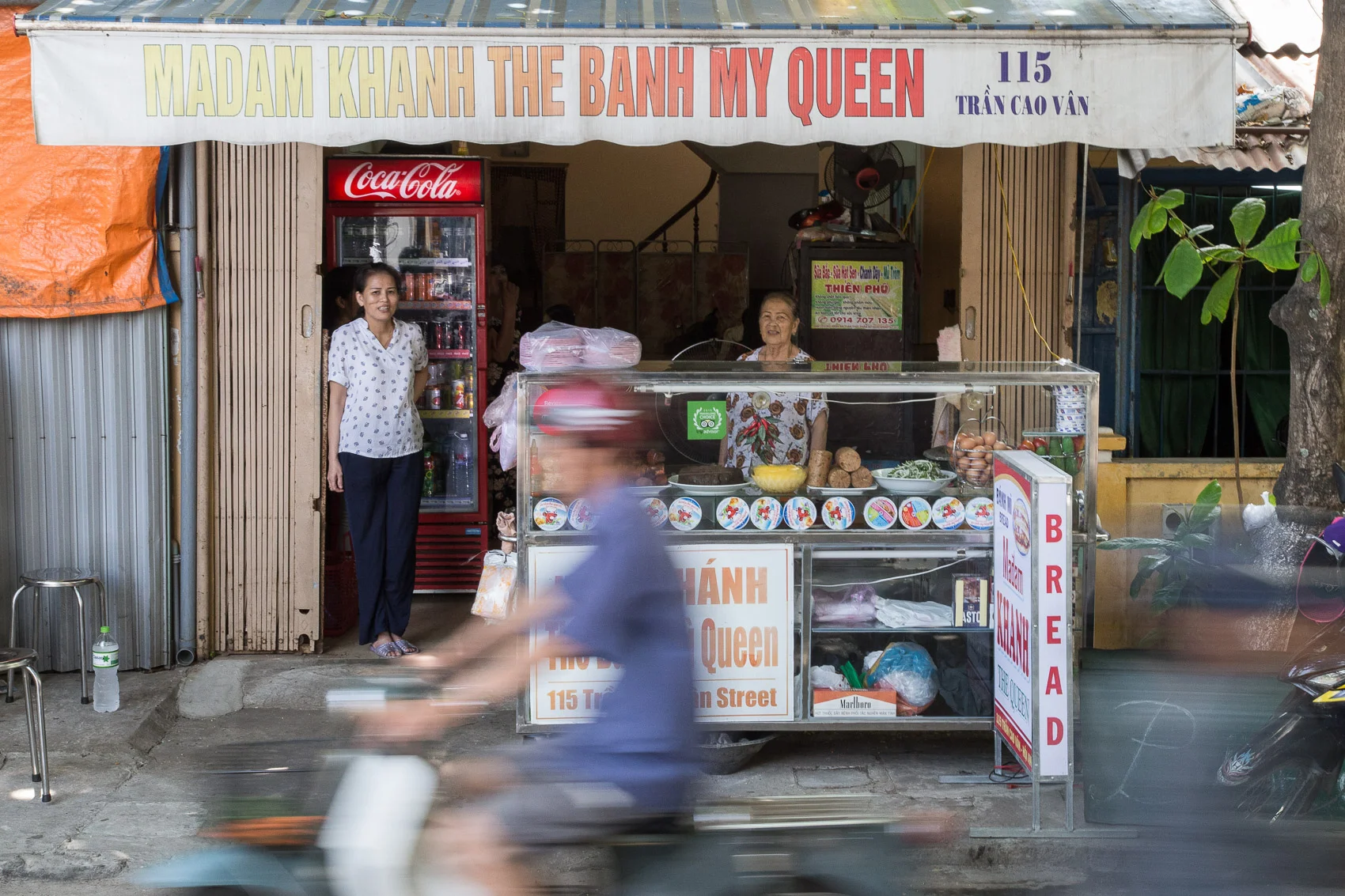battle of the banh mi

In the friendly, seaside streets of Hoi An, a quiet war has been raging for several years. It’s a battle for the patronage and affections of mostly western tourists. It’s a battle for the best banh mi – that ubiquitous and delicious pork roll phenomenon, evolved by Vietnamese people from French colonial days. (For a fascinating history of the dish freelancer Simon Stanley has written a comprehensive account here.)
In the one corner, Madam Khanh, the smiley octogenarian who has been filling fresh bread with her secret sauces for more than 50 years. In the other, Madam Phuong, a younger adversary with a slicker, production-line type business, once featured in Anthony Bourdain’s food travel series, No Reservations.
Whose banh mi reigns supreme?
Lifestyle Traveller sampled both on several occasions. Here are our observations.
Banh mi adversaries Madam Phuong (left) and Madam Khanh (right).
Madam Phuong, Banh Mi Phuong, 2B Phan Chau Trinh, Hoi An, phone +84 90 574 3773.
This is more of a banh mi restaurant than a traditional roadside stall. You’ll recognise it by the queues of tourists – Western and Asian – attempting to understand the chaotic ordering system. Despite an ‘order and pay here’ sign in the middle of the sideways counter the four-to-six women on banh mi-making duty are so busy getting other orders through it becomes somewhat of a free-for-all. An area at the rear of the shop serves as a sit-down banh mi-scoffing zone. Once your goods arrive you’ll find an extremely fresh white bun (the bakery is literally next door), stuffed with a large lettuce leaf, fresh tomato, cucumber, pork and crisp pork crackling, as well as the standard banh mi ingredients, such as cold cuts. In all, the ingredients are fresh and the sweet chilli hit is pleasingly not overpowering. Cost: VND 20,000-30,000 (AUD$1.20-$1.80).
Banh mi ingredients at Madam Phuong's business.
More behind-the-scenes views at Madam Phuong's.
Madam Phuong pictured behind her counter.
Madam Khanh “the Banh Mi Queen”, 115 Tran Cao Van, Hoi An, no phone.
This family-run banh mi stall has been operating in the same place for more than 30 years. You’ll find Madam “Banh Mi Queen” Khanh herself behind the counter but usually only in the mornings (now in her 80s, Madam Khanh tends to have a well-deserved nap in the afternoons). Wait times here are far less than at Madam Phuong’s and pork rolls here are quite different. A standard roll comes with a fried egg (over-easy) and no fresh salady ingredients. Instead, you’ll find pickled daikon, carrot and cucumber and char siu-style pork. The big difference is the amount of sauce and flavouring ladled into the roll at the end. The result is flavoursome but messy and tending towards the sloppy. Cost: VND 20,000 (AUD$1.18).
Madam Khanh (centre) behind her banh mi counter.
Behind-the-scenes at Madam Khan's banh mi business.
Madam Khanh generally serves in the mornings and naps in the afternoons, when her family takes over.
So, who is the winner? In terms of freshness and popularity it’s clearly Madam Phuong, although we’ve been back many times to Madam Khanh and happily licked our fingers clean.
But what do Hoi An locals think? For a start our sources would never pay more than VND 10,000 for a roll. Secondly, Phuong and Khanh both seem to pack too much stuff in for their tastes. Instead, they recommended a Mr Tao, on the corner of Le Loi and Tran Hung Dao Streets, for his more minimalist (and cheaper) offering. (When Lifestyle Traveller investigated we found a good, fresh roll but payed double the usual price of VND 10,000.) The reality is banh mi sellers are micro businesses that cater to hyper local tastes using the best ingredients at hand. That means in Da Nang, for example, while the bread is generally-speaking superior (excellent, crisp crusts and fluffy white interior) the fillings aren’t up to scratch. The opposite can be said of the banh mi available in Hoi An.
A bakery is almost directly next door to Madam Puong.
In Vietnam's tropical climate banh mi freshness is paramount. Humidity is a real factor here and bread tends to go stale and rubbery very quickly.
The final ingredient in all this banh mi talk is timing. Depending on your hunger, the freshness of the bread and the ingredients, the banh mi you get will likely vary, sometimes dramatically. The best time to eat is at breakfast (after 6am and before 9am) or in the afternoon (between 3pm and 5pm). Our most memorable banh mi came from a roadside seller close to the beach in Da Nang. We were all very hungry, the bread was fresh and at VND 10,000 (AUD$0.60) each, the price was just right.









